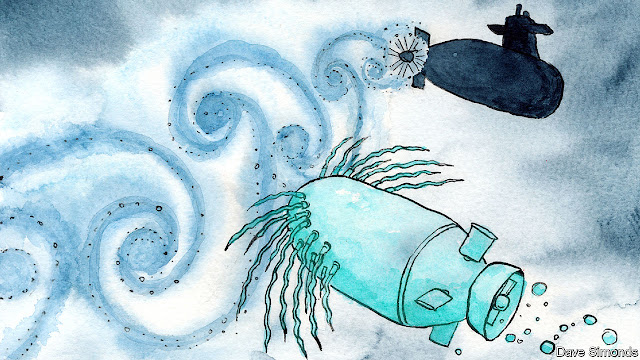An image from The Economist article is above. Clearly in submarine, UUV, AUV, seabed or harbour defense applications, "whisker" sensors may be useful to detect unnatural water flows. This may particularly be regular propeller movement vortices. "Whiskers" may be most useful in places like the Baltic Sea, where AIP is frequently used by Sweden and Germany, to minimize passive sonar detectable diesel emissions.
---
Whiskers are so prominent and regular on seals that they must be very valuable in detecting fish movement in totally opaque (eg. muddy) and low or no light environments.
---
So I located a 3DPRINT.COM article
of January 17, 2018. The following is an abridged version which begins:
“3D Printed Sensor
Mimics Seal Whiskers to Detect Underwater Vortices
by Clare Scott | Jan 17, 2018 | 3D Printing, Science & Technology |
The word
pinniped refers to semi-aquatic fin- or flipper-footed mammals, including to
seals, sea lions and walruses. These creatures also have whiskers, which...serve an important purpose – they help the
pinnipeds track their prey underwater by sensing the vortices left behind by
the movement of said prey. A group of researchers in the Department of
Mechatronics Engineering at Jeju National University in South Korea believe
that a sensor based on the pinnipeds’ method of hunting could be valuable for
soft robotics and underwater exploration, [Pete Comment: And to detect submarine and AUV water movement] they set out to create one using
3D printing.
The
research was described in a paper entitled “Fully 3D Printed Multi-Material
Soft Bio-Inspired Whisker Sensor for Underwater-Induced Vortex Detection,”
which you can read here...”
“The four graphene patterns (90° apart) on the polyurethane cylinder
enable the flow detection in all directions (0–360°). The length and diameter
of the polyurethane cylinder and graphene patterns are 160 × 8 mm and
60 × 0.3 mm, respectively,” the researchers explain. “The conductivity of the
printed graphene pattern is 0.6 Ω-cm. With a maximum deformation distance of
5 mm in any direction (0–360°), a substantial change in resistance is observed
(from 5.09 × 103 to 6.03 × 108 Ω). The change in resistance in four directions (up,
down, left, and right) is studied in an underwater environment.”
“.. The
dual-extruder 3D printer was used to print the sensor itself, using the first
head, out of polyurethane purchased from Fotopolymer, while the second head printed the graphene
patterns from filament bought from Black Magic 3D. After printing was complete, the base
and the patterns were connected using copper tape. Copper tape was also used to
solder signal wires, and a final 1mm water protection polyurethane layer was
dip coated and cured with UV light.
The
researchers then tested the sensors, using them to detect the vortices by
digitizing the analog signals that indicate resistance changes and sending them
to a microcontroller. They concluded that the design and fabrication of the
whisker sensor is simple, quick, low cost, and easily deployable in commercial
applications, as well as delivering good sensitivity and mechanical
reliability. Some further development is needed; however, the study was overall
a successful one...
Authors
of the paper include Jahan Zeb Gul, Kim Young Su, and Kyung Hyun Choi.”
SEE WHOLE 3DPRINT.COM ARTICLE WHICH HAS DIAGRAMS
In 2015 Dr. Heather Beem explained the mechanics of artificial whiskers.
---
---


No comments:
Post a Comment